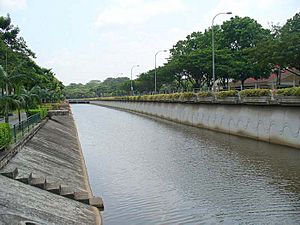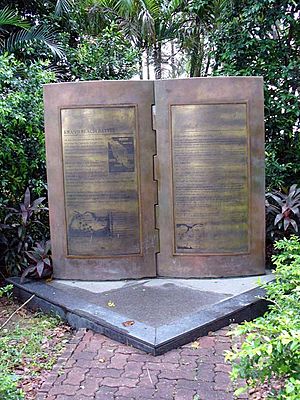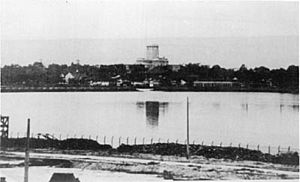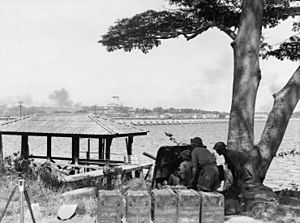Battle of Kranji facts for kids
Quick facts for kids Battle of Kranji |
|||||||
|---|---|---|---|---|---|---|---|
| Part of the Battle of Singapore, Pacific War | |||||||
 The Japanese invasion of Kranji in February 1942. The arrows indicate attacks by Japanese forces. |
|||||||
|
|||||||
| Belligerents | |||||||
| Commanders and leaders | |||||||
| Strength | |||||||
| ~2,000 | ~10,000 | ||||||
The Battle of Kranji was a key part of the Japanese plan to invade Singapore during World War II. It happened on February 9–10, 1942. Japanese forces attacked the northwest coast of Singapore, which was then the capital of the Straits Settlements.
Their main goal was to create another landing spot. This would help them break through the Jurong-Kranji defense line. They wanted to push south towards Singapore City. The Australian 27th Brigade, led by Brigadier Duncan Maxwell, defended the coast. They were helped by one company of local volunteers.
On February 10, the Japanese faced their toughest fight. They nearly gave up the attack. But, due to some mix-ups and withdrawals by Allied forces, the Japanese quickly gained ground. This eventually led to the fall of Singapore on February 15, 1942.
Contents
What Was Kranji Like?
The area around Kranji had many mangrove swamps and thick tropical forests. Streams and inlets cut through the land. The coastline, almost four kilometers long, was defended by the Australian 27th Brigade. Brigadier Duncan Maxwell led this group.
The 27th Brigade had three battalions of soldiers. They also had support from artillery and machine gun teams. A local volunteer group called Dalforce also helped. These volunteers were mostly Chinese Singaporeans. They had very little training and simple weapons. To avoid being mistaken for Japanese soldiers, they wore a red triangle on their blue shirts.
The Japanese forces attacking Kranji were from the Imperial Guards Division. Major General Takuma Nishimura led them. A small group of 400 Imperial Guards had landed on Pulau Ubin earlier. This was a trick attack on February 7. They met very little resistance there.
The Battle Begins
Japanese Landings: February 9, 1942
On February 9, two Japanese army divisions landed on Singapore's northwest coast. This was near the Sarimbun area. Here, the Battle of Sarimbun Beach had already started. Lieutenant-General Tomoyuki Yamashita led these Japanese forces. His headquarters was at the Sultan of Johor's palace. This palace gave him a clear view of Singapore.
The main goal for the Japanese at Kranji was to capture Kranji Village. This would let them fix the Causeway. Fixing the Causeway would allow more Japanese soldiers and supplies to enter Singapore easily. Once the first wave of Japanese landed, their artillery fired heavily on Kranji's defenses. Communication lines were destroyed, cutting off the front line from headquarters. That night, at 8:30 PM, the Imperial Guards began crossing from Johor. They used special landing crafts, collapsible boats, and even swam.
After midnight on February 9, one Australian battalion was moved. This left Brigadier Maxwell and the 27th Brigade with fewer soldiers. They had only two battalions for the upcoming fight, with no extra troops.
Heavy Losses for Japan: February 10, 1942
In the early morning of February 10, the Japanese suffered their biggest losses. As they moved up the Kranji River, their advance parties faced heavy fire. Australian machine guns and mortars hit them hard. They also found themselves in oil slicks. Allied soldiers had emptied the nearby Woodlands oil depot to prevent the Japanese from capturing it.
A terrible accident happened: Allied gunfire set the oil on fire. Many Japanese soldiers were burned alive. Because of these heavy losses, General Nishimura asked to stop the attack. But General Yamashita said no.
Brigadier Maxwell had poor communication with his headquarters. He worried his forces would be cut off by the fierce fighting to the southwest. This fighting involved another Australian brigade. So, Maxwell's forces pulled back from the coast. This allowed more Japanese soldiers to land and take Kranji village. They also captured Woodlands and started fixing the Causeway. They faced no attacks from the Allies.
Japanese tanks, like the Type 95 Ha-Gos, were towed across the straits. They joined the battle near Lim Chu Kang. With more enemy forces and tanks advancing, the Australian troops had to retreat. They fled southeast to the hills of Bukit Panjang. The Japanese 5th Division captured Bukit Timah Village by the evening of February 11.
The Jurong-Kranji Defense Line

Lieutenant-General Arthur Percival was the commander of the Malaya Command. He set up a defense line to protect Singapore City. This line covered Kallang Airfield, the MacRitchie and Peirce reservoirs, and the Bukit Timah supply depot.
One part of this defense was the Jurong-Kranji line. This was a narrow ridge that protected the northwest approach to Singapore Town. Troops were ordered to defend this line strongly. Indian and Australian brigades guarded the line. Another Indian brigade was moved near Bukit Timah Road. This was to protect the island's vital food and fuel supplies. Percival gave secret orders to his generals to protect this area.
A Costly Misunderstanding
General Percival's secret orders were to pull back to the last defense line only if necessary. But Brigadier Maxwell misunderstood this. He thought it was an order to pull back immediately. As a result, the Indian and Australian brigades left the Jurong-Kranji line on February 10.
General Archibald Wavell, the Allied commander, was worried. He feared the large supply depot would fall to the Japanese. He sent an urgent message to Percival:
It is certain that our troops in Singapore Island heavily outnumber any Japanese who have crossed the Straits. We must destroy them. Our whole fighting reputation is at stake and the honour of the British Empire. The Americans have held out in the Bataan Peninsula against a far heavier odds, the Russians are turning back the picked strength of the Germans. The Chinese with an almost lack of modern equipment have held the Japanese for four and a half years. It will be disgraceful if we yield our boasted fortress of Singapore to inferior enemy forces.
What Happened Next

By February 11, the Jurong-Kranji Defense Line was left open. This allowed Japanese forces to easily attack Bukit Timah. On the same day, Percival moved his headquarters to an underground bunker. This bunker was called The Battle Box at Fort Canning.
The Dalforce fighters were brave, but they lacked training and good equipment. The withdrawal of the Australian 27th Brigade made things worse. The Japanese then took control of the northern Woodlands area. This gave them an easy path into the island. General Wavell left Singapore for Java on February 11. He sent a message to British Prime Minister Winston Churchill in London. He said the battle for Singapore was not going well. He noted that some troops had low morale. He ordered Percival to counter-attack.
By February 12, the Imperial Guards had captured the reservoirs and Nee Soon village. The defending troops were very tired and scared. Thousands of soldiers left the fighting to find shelter. That night, British forces in the east of the island started to pull back towards the city.
On February 13, the Japanese 5th Division kept advancing. They reached Adam and Farrer Roads and captured the Sime Road Camp. Yamashita moved his headquarters to the damaged Ford Factory in Bukit Timah. The Japanese 18th Division moved south into Pasir Panjang. Here, the last major battle of Singapore was fought. It was between the Japanese and the Malay Regiments at Bukit Chandu.
Remembering the Battle
In 1995, the former battle sites of Kranji were recognized. The National Heritage Board named them as important World War II sites in Singapore.
See also
- Ee Hoe Hean Club
- Japanese order of battle during the Malayan campaign
- Kent Ridge Park
- Malaya Command
- Malayan campaign




